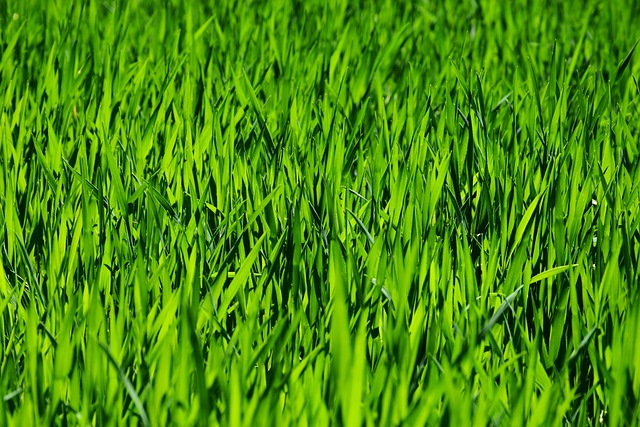Lawn care and landscaping are pivotal for creating a visually appealing and ecologically balanced outdoor space. Effective lawn maintenance involves selecting the right mowing height for your grass type to encourage deep root growth and minimize weed encroachment. Fertilization should be tailored to the specific nutritional needs of your turf, while water-efficient irrigation systems help conserve resources without compromising on lawn health. A healthy soil foundation is achieved through regular testing and amendments, which enhance its structure and fertility. Aeration combined with overseeding promotes a lush, resilient turf that can better withstand pests and diseases. Integrated pest management ensures that any pest control measures are both effective and environmentally friendly. Additionally, incorporating native plants and xeriscaping principles into your design conserves water and reduces maintenance efforts. Composting organic waste into nutrient-rich soil amendments is a sustainable alternative to synthetic fertilizers. The use of sustainable materials for hardscapes helps manage stormwater runoff, mitigate heat island effects, and minimize carbon emissions. These eco-conscious practices contribute to a harmonious blend of personal style, practical functionality, and environmental responsibility in your landscape design, resulting in a beautiful and sustainable outdoor living space that's both aesthetically pleasing and aligned with ecological principles.
Embark on a journey through the lush greenery of well-manicured lawns and imaginative landscaping designs that harmonize with the environment. This article delves into the art and science of lawn care and landscaping, offering insights into the foundational principles that sustain verdant spaces. Discover how to integrate eco-friendly practices into your outdoor design, ensuring both aesthetic appeal and ecological responsibility. From conceptualizing your vision to the practical steps of implementation, learn how to transform your green space into a living masterpiece. Join us as we explore the intricate world of Lawn Care and Landscaping, where every detail contributes to the overall beauty and health of your outdoor oasis.
- Foundational Principles of Lawn Care for a Thriving Landscape
- Integrating Eco-Friendly Practices into Your Landscaping Design
- Transforming Vision into Reality: The Step-by-Step Implementation of Your Landscaping Design
Foundational Principles of Lawn Care for a Thriving Landscape

Engaging in meticulous lawn care is foundational for nurturing a lush and vibrant landscape. A well-tended lawn not only elevates the aesthetic appeal of your outdoor space but also promotes ecological health. To achieve this, consistent mowing at the appropriate height for your grass type is crucial, as it encourages root growth and helps to prevent weed invasions. Fertilization should be tailored to the specific nutritional needs of your lawn’s species, ensuring a balanced supply of essential nutrients throughout the growing season. Irrigation practices should be optimized for efficiency, utilizing water-wise methods to conserve resources without compromising on grass health.
Healthy soil is the cornerstone of robust lawn care. Soil testing and amending can correct any deficiencies, improving soil structure and fertility. Aeration and overseeding are practices that enhance turf density and resilience against pests and diseases. Integrated pest management strategies should be employed to address any infestations in an environmentally responsible manner. Lastly, regular inspection and maintenance of irrigation systems ensure consistent delivery of water to your lawn, mitigating issues like overwatering or underwatering that can stunt grass growth or lead to dry patches. By adhering to these principles of lawn care, you lay the groundwork for a landscape that thrives throughout the seasons.
Integrating Eco-Friendly Practices into Your Landscaping Design

Incorporating eco-friendly practices into your lawn care and landscaping design can create a sustainable and beautiful outdoor space that benefits both the environment and your community. The use of native plants, for instance, not only supports local biodiversity but also reduces the need for supplemental watering and fertilization. These plants are adapted to the local climate and soil conditions, making them more resistant to pests and diseases, thereby minimizing the reliance on chemical treatments that can be harmful to ecosystems. Additionally, the implementation of xeriscaping principles can significantly cut down on water usage by utilizing drought-resistant plants, efficient irrigation systems, and proper soil preparation to retain moisture. Mulching is another eco-conscious approach that helps maintain soil moisture, suppresses weeds, and improves soil health, all while contributing to a neat and well-maintained appearance.
Composting organic waste not only diverts material from landfills but also provides a nutrient-rich soil amendment that supports plant growth naturally. By composting, you can reduce the need for chemical fertilizers, which can contribute to water pollution. Furthermore, choosing sustainable materials for hardscapes like paths and patios, such as permeable pavers or recycled content, can help manage stormwater runoff, reduce heat island effects, and lower the carbon footprint of your landscaping design. These practices collectively contribute to a more sustainable environment while also creating a harmonious and visually appealing outdoor living space that aligns with the principles of lawn care and landscaping dedicated to environmental stewardship.
Transforming Vision into Reality: The Step-by-Step Implementation of Your Landscaping Design

Engaging in landscaping design is a transformative process that breathes life into your outdoor space, creating an environment that reflects both personal taste and environmental harmony. The journey from concept to completion involves careful planning and execution. Begin by envisioning the ideal landscape, considering the unique characteristics of your property, including sun exposure, soil type, and existing flora and fauna. This initial phase is where lawn care becomes paramount; a healthy lawn serves as a foundation for your design, setting the stage for the beauty and functionality of the entire space.
Once your vision is clear, the next step is to translate it into a detailed plan. Measure your yard, and use landscape design software or consult with a professional landscaper to draft a comprehensive layout that includes plant selection, garden beds, hardscaping features like pathways and retaining walls, and the placement of outdoor structures such as pergolas or water features. With this plan in hand, you can proceed to the implementation phase. This involves preparing the soil, choosing high-quality plants suited to your local climate, and installing irrigation systems to ensure consistent hydration and nutrients for optimal lawn care and plant health. Each element is installed with precision, from the laying of sod or seeding of a new lawn to the careful placement of each shrub, tree, and ornamental feature. Regular maintenance, including mowing, fertilizing, and pest control, is essential to maintain the aesthetics and vitality of your landscape. As you progress through each stage of implementation, stay attuned to the evolving design, making adjustments as necessary to ensure that your vision is fully realized in a thriving, sustainable outdoor space.
In wrapping up our exploration of landscaping design, it’s clear that a well-tended lawn and thoughtful integration of eco-friendly practices not only elevate the aesthetic appeal but also promote sustainability. By adhering to the foundational principles of lawn care outlined earlier, homeowners can foster a thriving landscape that serves as a living, breathing extension of their home. The step-by-step guide to transforming one’s vision into a tangible outdoor space offers a blueprint for successful landscaping design implementation. For those committed to nurturing their outdoor environment, the synergy between meticulous lawn care and eco-conscious choices promises a harmonious and enduring garden that contributes positively to both the local ecosystem and personal well-being. Landscaping design, when approached with mindfulness and attention to detail, becomes an art form that enhances one’s living space and respects the environment.
